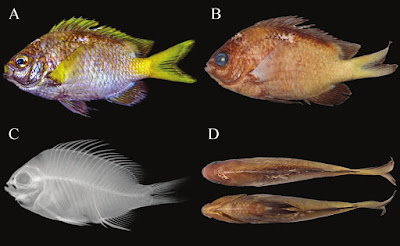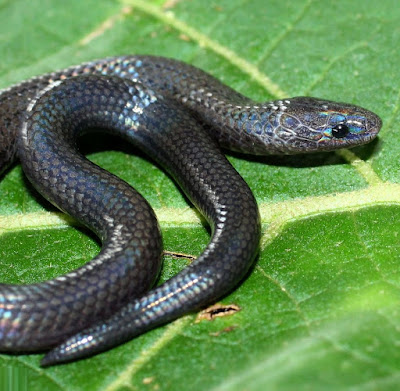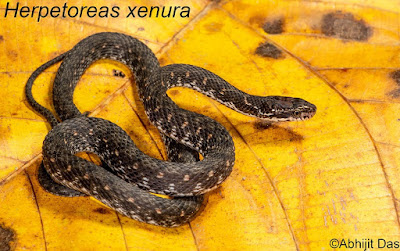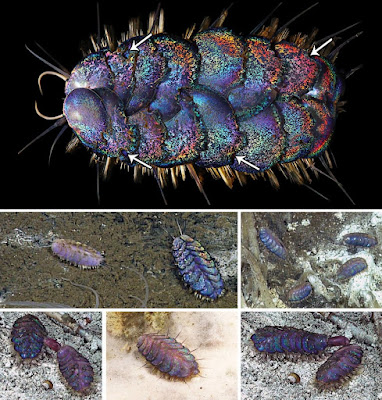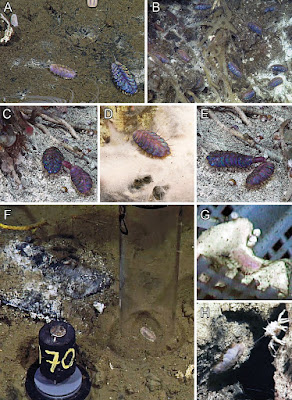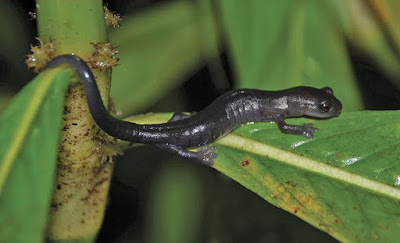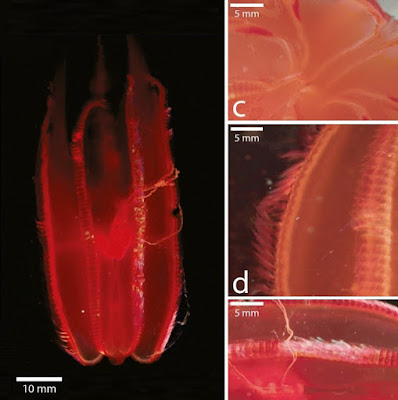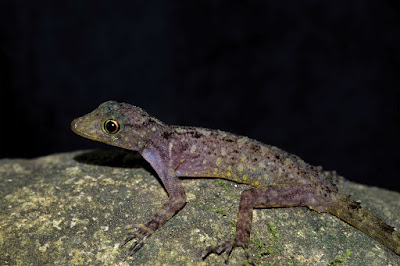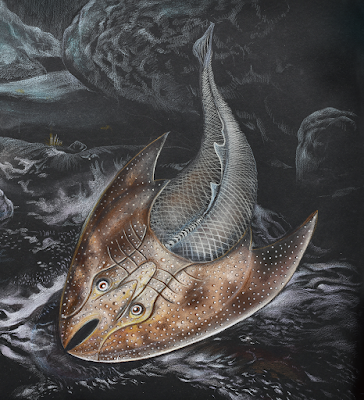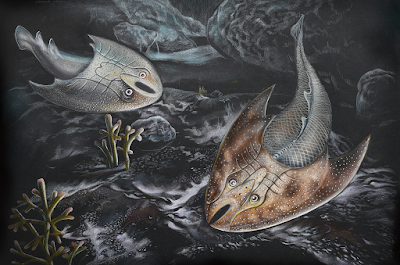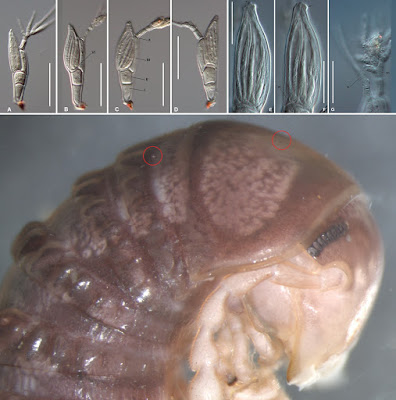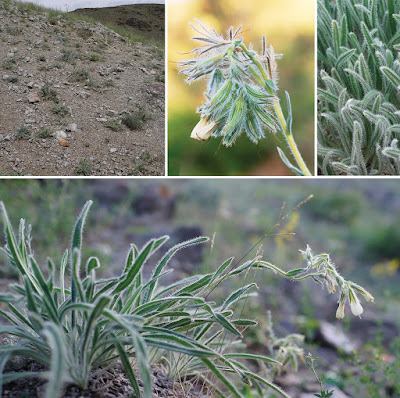[Most Recent Entries] [Calendar View]
Sunday, May 17th, 2020
| Time | Event | ||||||
| 6:01a | [Herpetology • 2020] Rhinophis melanoleucus • A New Species of Rhinophis Hemprich, 1820 (Serpentes: Uropeltidae) from the Wayanad Region of peninsular India
Abstract A new species of the shieldtail snake genus Rhinophis is described based on a type series of seven recently collected specimens from the Wayanad region of the Western Ghats of peninsular India. Rhinophis melanoleucus sp. nov. is diagnosed based on a combination of 15 dorsal scale rows at (or just behind) midbody, more than 215 ventral scales and a long rostral. The new species also has a distinctive (mostly black and white) colouration. A new key to the identification of Indian species of Rhinophis is provided. Keywords: Serpentes, identification key, shieldtail, snakes, taxonomy, Western Ghats
Rhinophis melanoleucus sp. nov. Diagnosis. Rhinophis melanoleucus sp. nov. differs from all other species of Rhinophis except R. sanguineus and R. fergusonianus in having 15 dorsal scale rows at (or just behind) midbody (versus 17 or 19 in other congeners). Rhinophis melanoleucus sp. nov. differs from R. fergusonianus in having > 215 ventrals (known range 218–236) versus 195 in the only known specimen of R. fergusonianus. Rhinophis melanoleucus sp. nov. differs from R. sanguineus in having more ventral scales (218–236 versus 181–214 in specimens examined here – see Discussion for comment on Wall’s 1919 report of ventral counts in R. sanguineus of up to 218), in having dark blotches (versus spots) on the ventral surface, and in having a proportionately longer rostral shield: 40.8–42.9% (n = 7; mean 42.0%) versus 32–39.3% (n = 17; mean 36.9%) of head length (= distance between snout tip and posterior edge of fourth supralabial). Only a single nomen is currently considered a synonym of any Indian Rhinophis species—R. microlepis Beddome, 1863 is a subjective junior synonym of R. sanguineus (e.g. Beddome 1886, Smith 1943, Gans 1966, McDiarmid et al. 1999, Pyron et al. 2016). The holotype of R. microlepis differs from the type series of the new species in having a mottled or speckled rather than blotched venter, in having fewer than 218 ventrals (214), and in having a shorter rostral shield (35.8% of head length versus 41% or more). Etymology. From the Ancient Greek mélas (black) and leukós (white), in reference to the unusual (for uropeltids) black and white colouration. For nomenclatural purposes, the species name melanoleucus is a noun in the genitive case. Distribution, habitat, natural history and conservation status. Rhinophis melanoleucus sp. nov. is known only from the vicinity of Lakkidi in the Wayanad District of Kerala state, at approximately 750–850 m elevation in the evergreen hills of the Western Ghats. The habitat in the vicinity of the type locality is shown in Fig. 7. We suspect that the new species has a larger distribution, at least in the Wayanad region, but it is not widespread and/or frequently encountered enough to have been previously collected or reported. The new species is likely to qualify for Data Deficient status under IUCN Red List criteria, at least until new field surveys are undertaken and/or additional specimens from other localities can be found in other collections. The holotype was found at 08:00, moving on the surface of a forest track alongside a stream and close to an adjacent tea plantation. Paratypes BNHS 3537 and BNHS 3538 were found at 15:00 and 09:00, respectively, the former dead on a paved road, and the latter on the ground surface in an abandoned coffee plantation. Referred specimen BNHS 3539 was dug from a depth of approximately 0.5 m during excavations for a road extension in mid-elevation wet-evergreen forest (rainfall approximately 5,000 mm per year) with trees including Cinnamomum malabatrum (Burm. f.) J.Presl, Meliosma simplicifolia (Roxb.), Actinodaphne malabarica Balakr. and Elaeocarpus tuberculatus Roxb. in addition to farmed coffee. Paratypes ZSI/WGRC/IR/V/3100 and ZSI/WGRC/IR/V/3101 were found at approximately 07.00 and 18.30 respectively, moving among grass on the side of a tarred road inside the Veterinary and Animal Sciences University campus, Pookode. Paratypes BNHS 3535 and BNHS 3536 were found dead on a tarred road between 07.00 and 08.00. In a few days of temporary captivity, BNHS 3538 refused to feed on live earthworms provided. When handled, none of the individuals in the type series attempted to bite. They showed an inclination to burrow in soil and in the hand. At the localities reported here, Rhinophis melanoleucus sp. nov. occurs broadly sympatrically (within a radius of ca. 15 km) with other uropeltids including at least i. sanguineus, Uropeltis cf. nilgherriensis, Teretrurus hewstoni, Melanophidium bilineatum and M. wynaudense. Vivek P. Cyriac, Surya Narayanan, Filipa L. Sampaio, Pavukandy Umesh and David J. Gower. 2020. A New Species of Rhinophis Hemprich, 1820 (Serpentes: Uropeltidae) from the Wayanad Region of peninsular India. Zootaxa. 4778(2); 329–342. DOI: 10.11646/zootaxa.4778.2.5 | ||||||
| 6:01a | [Ichthyology • 2020] Chromis mamatapara • A New Species of Chromis (Teleostei: Pomacentridae) from Mesophotic Coral Ecosystems of Rapa Nui (Easter Island) and Salas y Gómez, Chile
Abstract A new species of Chromis (Teleostei: Pomacentridae) is described from three specimens collected at 90 m depth in a mesophotic coral ecosystem at Rapa Nui, Chile. Chromis mamatapara, new species, can be distinguished from its congeners by the following combination of characters: dorsal-fin rays XIV,13–14; pectoral-fin rays 18–19, third from top of fin longest; tubed lateral-line scales 18; total gill rakers on first arch 30–32; vertebrae 11+15; and by coloration of living specimens, especially the presence of a single, pronounced, white spot, roughly the same diameter as the orbit, located where the posterior base of the dorsal fin intersects the caudal peduncle. The most similar DNA barcode (mitochondrial COI gene), among those available, is Chromis tingting from Japan (3.5% uncorrected divergence); however, C. mamatapara, new species, also superficially resembles other species for which sequences are unavailable for comparisons, including C. okamurai from Japan and C. struhsakeri from Hawaii. Due to the high geographic isolation and consequently high endemism in the Rapa Nui region, we believe that C. mamatapara, new species, is endemic to mesophotic ecosystems of Rapa Nui, Isla Salas y Gómez, and nearby seamounts, a discovery that contributes to the high endemism of the region and thus the need for conservation efforts. Chromis mamatapara, new species English Common Name: Michel's Chromis Spanish Common Name: Castañeta de Michel Diagnosis.—The following combination of characters distinguishes Chromis mamatapara, new species, from all of its congeners: dorsal-fin rays XIV (versus XV in C. randalli, the only other congener in the area, and XII–XIII or XV in most other Indo-Pacific species), 13–14 (versus 10 in C. randalli); anal-fin rays II,12 (versus II,10–11 in C. randalli); pectoral-fin rays 18–19 (versus 21–22 in C. randalli); principal caudal-fin rays 8+7; spiniform procurrent caudal-fin rays 2; tubed lateral-line scales 18 (versus 21–22 in C. randalli); posterior, mid-lateral scales with pore or deep pit 8–9; vertebrae 11+15; gill rakers 9–10+21–23; total gill rakers 30–32 (versus 33–37 in C. randalli); body moderately deep, depth 1.8–2.0 in SL (versus 2.3–3.0 in C. randalli); tail and caudal peduncle yellow; distal edge of caudal peduncle at junction of posterior dorsal fin with a large white spot, its diameter about width of orbit (Fig. 1). Etymology.— The specific epithet is a compound word meaning “yellow damselfish” (māmata para) in Rapanui, in reference to the overall body coloration in life. To be treated as a noun in apposition. The suggested English common name, Michel's Chromis (Castañeta de Michel in Spanish), is in honor of the late Michel Garcia, who greatly assisted our field work in Rapa Nui, and unfortunately died in May 2018. Habitat and distribution.— Chromis mamatapara is only known to occur at Rapa Nui (Easter Island), Isla Salas y Gómez, and the seamount Pukao (∼85 km west of Rapa Nui). Due to the high degree of endemism (21.7%) among the shore fishes of Rapa Nui (Delrieu-Trottin et al., 2019), it is likely that Chromis mamatapara is endemic to this region. The collected fish were recorded at a depth of 90 m in a rocky patch reef surrounded by a large sandy area. Adults have also been observed with ROV surveys at Rapa Nui at 90–230 m and Pukao at 150–190 m in rocky patch reefs surrounded by sandy areas, around rhodoliths and fields of whip coral (Stichopathes), along rock walls interspersed with sandy areas, and dead or mostly dead reefs of Leptoseris. Juveniles of the new species have been observed during ROV surveys in association with Stichopathes at Pukao at 165 m and Rapa Nui at and 150–157 m (Easton et al., 2019; Fig. 2A). Bart Shepherd, Hudson T. Pinheiro, Tyler A. Y. Phelps, Erin E. Easton, Alejandro Pérez-Matus and Luiz A. Rocha. 2020. A New Species of Chromis (Teleostei: Pomacentridae) from Mesophotic Coral Ecosystems of Rapa Nui (Easter Island) and Salas y Gómez, Chile. Copeia. 108(2); 326-332. DOI: 10.1643/CI-19-294 | ||||||
| 6:30a | [Paleontology • 2020] Revision of Nannopterygius (Ichthyosauria: Ophthalmosauridae): Reappraisal of the ‘Inaccessible’ Holotype resolves A Taxonomic Tangle and reveals An Obscure Ophthalmosaurid Lineage with A Wide Distribution
Abstract The Late Jurassic ichthyosaur Nannopterygius is among the poorest known, with the only skeleton, NHMUK PV 46497, on display in the Natural History Museum, London and, therefore, difficult to access. This holotype specimen is here reassessed. The newly obtained data have enabled the identification of several additional specimens of Nannopterygius in museum collections across the UK. Furthermore, all the material of Russian ichthyosaurs previously referred to genera Paraophthalmosaurus and Yasykovia, and considered as junior synonyms of Ophthalmosaurus in the majority of subsequent works, are also reassessed. Both these genera are synonymized with Nannopterygius with preservation of the two from six originally erected species: Nannopterygius saveljeviensis comb. nov. and Nannopterygius yasykovi comb. nov. Additionally, a new species from the Berriasian of Arctic (Svalbard and Franz Josef Land) is proposed. To resolve the phylogenetic relations within Ophthalmosauria, a revised dataset, including 44 taxa and 134 characters, 20 of which are new, was compiled. The results of a phylogenetic analysis places Nannopterygius spp. as sister to Arthropterygius spp. within Ophthalmosaurinae. Thus, the lineage of Nannopterygius was among several ophthalmosaurine lineages that crossed the Jurassic–Cretaceous boundary and, similarly to Arthropterygius, survived the Jurassic–Cretaceous transition at high latitudes. Keywords: Boreal Realm, Jurassic/Cretaceous transition, Kimmeridgian, Paraophthalmosaurus, phylogeny, Tithonian, Yasykovia Nikolay G Zverkov and Megan L Jacobs. 2020. Revision of Nannopterygius (Ichthyosauria: Ophthalmosauridae): Reappraisal of the ‘Inaccessible’ Holotype resolves A Taxonomic Tangle and reveals An Obscure Ophthalmosaurid Lineage with A Wide Distribution. Zoological Journal of the Linnean Society. zlaa028. DOI: 10.1093/zoolinnean/zlaa028 | ||||||
| 7:09a | [Ichthyology • 2020] Sphyraena stellata • A New Barracuda (Perciformes: Sphyraenidae) from the Indo-Pacific, with Redescriptions of S. helleri & S. novaehollandiae
Abstract A new barracuda, Sphyraena stellata, is described on the basis of 41 specimens [98.0–587.0 mm standard length (SL)] collected from the Indo-Pacific. The new species can be distinguished from all congeners in having the following combination of characters: one gill raker on first gill arch; pelvic-fin insertion located slightly before vertical through first dorsal-fin origin; pored lateral-line scales 134–141 (modally 137), total lateral-line scales 139–148 (146); scales above and below lateral line 15–17 (15) and 14–16 (15), respectively; snout comparatively short, its length 13.6–15.8 (mean 14.4) % SL; upper jaw short, its posterior tip not reaching to below anterior nostril, its length 10.0–12.2 (10.8) % SL; eye small, orbit diameter and depth 4.3–7.0 (4.9) and 3.9–5.6 (4.5) % SL, respectively; anal-fin base shortish, its length 6.9–8.1 (7.5) % SL; last dorsal- and anal-fin ray lengths 4.0–5.6 (4.7) and 3.6–5.6 (4.6) % SL, respectively; anus not close to anal-fin origin, anterior and posterior margins of former to anal-fin origin 7.5–11.9 (9.9) and 5.2–8.3 (6.8) % of head length, respectively; head sensory canal pores on suborbital area simple or slightly branched, their lowermost parts not close to margin of lacrimal bone, large smooth area lacking canal pores on mid-margin of lacrimal bone; two yellow stripes on lateral surface of body (remaining as black stripes in preserved specimens); and caudal fin gray. In addition, S. helleri Jenkins, 1901 and S. novaehollandiae Günther, 1860, both being closely related to the new species, are redescribed on the basis of 4 (243.3–545.8 mm SL) and 15 (270.8–598.0 mm SL) specimens, including holotypes, respectively, with new diagnostic characters proposed for both species. Keywords: Perciformes, morphology, taxonomy, description, distribution  Sphyraena stellata n. sp. [New English name: Yellow-striped Barracuda; Japanese name: Hoso-kamasu カマス] Etymology. The specific name stellata is derived from Latin meaning starry, referring to the two yellow lateral stripes on the body. Satoshi Morishita and Hiroyuki Motomura. 2020. Sphyraena stellata, A New Barracuda from the Indo-Pacific, with Redescriptions of S. helleri Jenkins, 1901 and S. novaehollandiae Günther, 1860 (Perciformes: Sphyraenidae). Zootaxa. 4772(3); 545–566. DOI: 10.11646/zootaxa.4772.3.6 | ||||||
| 7:09a | [Herpetology • 2020] A Multilocus Molecular Perspective on the Systematics of the poorly Known Northeast Indian Colubrid Snakes Blythia reticulata, B. hmuifang & Hebius xenura
Abstract We provide the first molecular phylogenetic data for the following poorly known Northeast Indian snakes: Blythia reticulata and B. hmuifang, Hebius xenura, and Trachischium spp. Based on 1071 bp of cytb, 578 bp of nd4, 509 bp of 16s, 1000 bp of rag1 and 672 bp of cmos, we found support for a monophyletic Blythia being a member of Natricinae, most closely related to Trachischium. Hebius xenura is recovered as nested within species of the recently resurrected genus Herpetoreas, to which we transfer it. Keywords: Reptilia, Colubridae, DNA, Natricinae, phylogeny, taxonomy, Trachischium Herpetoreas xenura (Wall, 1907) Samuel Lalronunga, C. Lalrinchhana, Vanramliana Vanramliana, Abhijit Das, David J. Gower and V. Deepak. 2020. A Multilocus Molecular Perspective on the Systematics of the poorly Known Northeast Indian Colubrid Snakes Blythia reticulata (Blyth, 1854), B. hmuifang Vogel, Lalremsanga & Vanlalhrima, 2017, and Hebius xenura (Wall, 1907). Zootaxa. 4768(2); 193–200. DOI: 10.11646/zootaxa.4768.2.2 | ||||||
| 7:25a | [Invertebrate • 2020] Hungry Scale Worms: Phylogenetics of Peinaleopolynoe (Polynoidae, Annelida), with Four New Species from the Pacific Ocean
Abstract Polynoidae Kinberg, 1856 has five branchiate genera: Branchipolynoe Pettibone, 1984, Branchinotogluma Pettibone, 1985, Branchiplicatus Pettibone, 1985, Peinaleopolynoe Desbruyères & Laubier, 1988, and Thermopolynoe Miura, 1994, all native to deep-sea, chemosynthetic-based habitats. Of these, Peinaleopolynoe has two accepted species; Peinaleopolynoe sillardi Desbruyères & Laubier, 1988 (Atlantic Ocean) and Peinaleopolynoe santacatalina Pettibone, 1993 (East Pacific Ocean). The goal of this study was to assess the phylogenetic position of Peinaleopolynoe, utilizing DNA sequences from a broad sampling of deep-sea polynoids. Representatives from all five branchiate genera were included, several species of which were sampled from near the type localities; Branchinotogluma sandersi Pettibone, 1985 from the Galápagos Rift (E/V “Nautilus”); Peinaleopolynoe sillardi from organic remains in the Atlantic Ocean; Peinaleopolynoe santacatalina from a whalefall off southern California (R/V “Western Flyer”) and Thermopolynoe branchiata Miura, 1994 from Lau Back-Arc Basin in the western Pacific (R/V “Melville”). Phylogenetic analyses were conducted using mitochondrial (COI, 16S rRNA, and CytB) and nuclear (18S rRNA, 28S rRNA, and H3) genes. The analyses revealed four new Peinaleopolynoe species from the Pacific Ocean that are formally described here: Peinaleopolynoe orphanae Hatch & Rouse, sp. nov., type locality Pescadero Basin in the Gulf of California, Mexico (R/V “Western Flyer”); Peinaleopolynoe elvisi Hatch & Rouse, sp. nov. and Peinaleopolynoe goffrediae Hatch & Rouse, sp. nov., both with a type locality in Monterey Canyon off California (R/V “Western Flyer”) and Peinaleopolynoe mineoi Hatch & Rouse, sp. nov. from Costa Rica methane seeps (R/V “Falkor”). In addition to DNA sequence data, the monophyly of Peinaleopolynoe is supported by the presence of ventral papillae on segments 12–15. The results also demonstrated the paraphyly of Branchinotogluma and Lepidonotopodium Pettibone, 1983 and taxonomic revision of these genera is required. We apply the subfamily name Lepidonotopodinae Pettibone 1983, for the clade comprised of Branchipolynoe, Branchinotogluma, Bathykurila, Branchiplicatus, Lepidonotopodium, Levensteiniella Pettibone, 1985, Thermopolynoe, and Peinaleopolynoe. Keywords: deep sea, molecular phylogeny, seeps, systematics, vents, whalefalls Taxonomy Polynoidae Kinberg, 1856 Lepidonotopodinae Pettibone, 1983 Peinaleopolynoe Desbruyères & Laubier, 1988, emended Type species: Peinaleopolynoe sillardi Desbruyères & Laubier, 1988 Diagnosis (emended): Twenty-one segments. Elytra large, sub-reniform, overlapping, and covering dorsum. Elytra with or without papillae and/or posterior extensions. Chaetae extending beyond the edge of elytra. Nine or ten pairs elytra and elytrophores on segments 2, 4, 5, 7, 9, 11, 13, 15, 17, 19, or lacking on 19. Pharynx with either seven pairs of border papillae, six pairs of border papillae, or seven dorsal and six ventral border papillae. Bilobed prostomium with triangular anterior lobes bearing lateral antennae (= minute frontal filaments, sensu Pettibone 1993). Median antenna in anterior notch. Paired palps. Eyes lacking. Achaetous segment 1 not visible dorsally and contains dorsal and ventral pairs of smooth, tapering anterior cirri (= tentacular cirri, sensu Pettibone 1993). Parapodia biramous. Neuropodia ranging from ca. twice the length to almost as long as notopodia. Dorsal tubercles, in line with elytrophores, on non-elytrigerous segments possessing small groups of branchiae. Notochaetae bundles stout. Neurochaetae long, slender. Dorsal cirri present on non-elytrigerous segments. In specimens with nine pairs elytra, segment 19 modified, lacking dorsal cirri. Cylindrical cirrophores and long distal styles (extending far beyond length of chaetae) of dorsal cirri. Arborescent branchiae beginning on segment 2 or 3 and continuing to near end of body. Branchiae attached on bases of notopodia and on dorsal tubercles. Four pairs of ventral segmental papillae on segments 12–15. Pygidium with a pair of anal cirri. Peinaleopolynoe santacatalina Pettibone, 1993 Peinaleopolynoe orphanae Hatch & Rouse, sp. nov. Etymology: Peinaleopolynoe orphanae sp. nov. is named after Dr. Victoria J. Orphan, not only for her invaluable research on deep-sea microorganisms, but also for her exploration of deep-sea chemosynthetic ecosystems and her love of the animals that thrive there. Ecology: Peinaleopolynoe orphanae sp. nov. is unusual among Peinaleopolynoe in that most specimens were associated with bacterial mats adjacent to hydrothermal vents in the Pescadero Basin at ~3700 m depth. One specimen (SIO-BIC A10926) was found at a cold seep with abundant vesicomyid clams suggesting that P. orphanae sp. nov. may be more of a habitat generalist than its close relatives. Peinaleopolynoe orphanae sp. nov. displayed an interesting fighting behavior in situ (Fig. 6C, E), in which an individual used its everted pharynx to attack an opponent’s elytra; the two individuals attacked one another back and forth for several minutes (Suppl. material 2: movie). This may explain the damaged elytra with apparent bite marks on the posterior edges in the holotype (Fig. 7A) and in several other paratypes collected (Fig. 11A, B, E). Peinaleopolynoe elvisi Hatch & Rouse, sp. nov. Etymology: Peinaleopolynoe elvisi sp. nov. is named after the legendary King of Rock and Roll, Elvis Presley; the iridescent golden/pink elytra are reminiscent of the sparkly, sequined costumes he favored in his late career. Ecology: All specimens of P. elvisi sp. nov. were found associated with vertebrate bones or wood (Table 5). Fig. 6F shows the holotype observed in situ on sediment next to a whalefall just before collection. Fig. 6G shows paratype SIO-BIC A9699 observed in situ on a deployed pig bone before collection. Peinaleopolynoe goffrediae Hatch & Rouse, sp. nov. Etymology: Peinaleopolynoe goffrediae sp. nov. is named after Dr. Shana K. Goffredi for her notable contribution to the exploration and research of deep-sea chemosynthetic ecosystems (especially whalefalls), focusing on symbiotic relationships between bacteria and marine invertebrates. Ecology: Peinaleopolynoe goffrediae sp. nov. was only found associated with a whalefall (Table 5). Fig. 6H shows the holotype observed in situ on a whale carcass before collection. Peinaleopolynoe mineoi Hatch & Rouse, sp. nov. Etymology: Peinaleopolynoe mineoi sp. nov. is named after Ronald M. Mineo, MD, in recognition of support from the Mineo family, their interest in the deep sea, and support for our research. Ecology: Peinaleopolynoe mineoi sp. nov. was found associated with bones and wood (Table 5). Like P. santacatalina and P. orphanae sp. nov., it may be more of a habitat generalist than other Peinaleopolynoe. Avery S. Hatch, Haebin Liew, Stéphane Hourdez and Greg W. Rouse. 2020. Hungry Scale Worms: Phylogenetics of Peinaleopolynoe (Polynoidae, Annelida), with Four New Species. ZooKeys. 932: 27-74. DOI: 10.3897/zookeys.932.48532 | ||||||
| 7:35a | [Herpetology • 2020] Bolitoglossa coaxtlahuacana • A New Species of Bolitoglossa (Caudata: Plethodontidae) from the central Highlands of Guerrero, Mexico
Abstract We describe a new species of salamander of Bolitoglossa (Oaxakia) Parra-Olea, García-París and Wake, 2004 from the cloud forests of the central portion of the Sierra Madre del Sur highlands in the Mexican state of Guerrero. Bolitoglossa coaxtlahuacana sp. nov. is currently known only from the type locality and can be differentiated from other members of the group by morphological, coloration, and molecular evidence. With the description of this new taxon, the number of species in the subgenus Oaxakia increases to six. Keywords: Bolitoglossa coaxtlahuacana, salamander, Sierra Madre del Sur, taxonomy
Bolitoglossa coaxtlahuacana sp. nov. Coaxtlahuacán Salamander, Salamandra de Coaxtlahuacán ETYMOLOGY: The species name refers to the small village of Coaxtlahuacán, Guerrero, from which the type series was obtained, and honors its inhabitants for their helpfulness and friendliness while conducting our fieldwork since late 2015. DISTRIBUTION AND HABITAT: Bolitoglossa coaxtlahuacana is known only from the type locality in a small mountain range that we call herein as Sierra de Mochitlán because it covers most of the municipality of Mochitlán, Guerrero (Fig. 3). The main vegetation formation at the type locality consists of humid oak forests with distinct degrees of perturbance. However, in many ravines and trails mostly in the southward slopes of this small mountain range, a more “cloud forest like” vegetation is present where ferns, mosses, orchids, and bromeliads abound (either in epiphytic and saxicolous situations) and dominant tree species show a mixture of both tropical and temperate representatives. Ricardo Palacios-Aguilar, Antonio Yolocalli Cisneros-Bernal, J. Diego Arias-Montiel, and Gabriela Parra-Olea. 2020. A New Species of Bolitoglossa (Amphibia: Plethodontidae) from the central Highlands of Guerrero, Mexico. Canadian Journal of Zoology. DOI: 10.1139/cjz-2019-0244 Résumé: Nous décrivons une nouvelle espèce de salamandre du sous-genre Bolitoglossa (Oaxakia) Parra-Olea, García-París et Wake, 2004, des forêts de nuages de la partie centrale des hautes terres de la Sierra Madre del Sur, dans l’État mexicain de Guerrero. Bolitoglossa coaxtlahuacana sp. nov. n’est actuellement connu que de la localité type et peut être distingué d’autres membres du groupe sur la base d’observations morphologiques, moléculaires et relatives à la coloration. La description de ce nouveau taxon fait passer le nombre d’espèces dans le sous-genre Oaxakia à six. [Traduit par la Rédaction] Mots-clés: Bolitoglossa coaxtlahuacana, salamandre, Sierra Madre del Sur, taxonomie | ||||||
| 7:43a | [Invertebrate • 2020] Vampyroctena delmarvensis (Vampyroctenidae, fam. nov.) • A Mesopelagic Ctenophore representing A New Family, with Notes on Family-level Taxonomy in Ctenophora
Abstract The stunning diversity of midwater ctenophores is well-known to veterans of oceanographic cruises and ROV operations, but many species lack formal descriptions, leading to taxonomic confusion and a systematic underestimation of the biodiversity of the mesopelagic zone. Here, we present a description of a novel genus and species of one such ctenophore, Vampyroctena delmarvensis gen. nov. sp. nov. This cydippid ctenophore, the sole described representative of Vampyroctenidae fam. nov. (Class Tentaculata, Order Cydippida), was collected in mesopelagic waters off the coast of Delaware in the northwest Atlantic Ocean and has a characteristic bright red mesoglea, large paragastric diverticulae, deep red macrocilia, and a darkly pigmented gut. A molecular phylogenetic analysis of Ctenophora based on transcriptomic data places V. delmarvensis gen. nov. sp. nov. as the closest known relative to Euplokamis dunlapae Mills, 1987 (Euplokamididae), in a clade that is sister to all other ctenophore lineages. Keywords: 18S, Atlantic Ocean, Delmarva, Molecular phylogeny, New species, Transcriptome, Tucker trawl
Systematics Vampyroctenidae fam. nov. Townsend, Damian-Serrano & Whelan Vampyroctena gen. nov. Townsend, Damian-Serrano & Whelan Etymology: Compound feminine noun derived from the French “vampyre” and Greek κτεíς, κτενóς, “comb.” This metaphorical comparison to mythological creatures refers to the dark gut pigmentation, which may serve as a “cloak” enabling them to hide bioluminescence emitted from captured prey, and the blood red pigmentation of the epithelium, comb plates, and mesoglea. Diagnosis: Tentaculate ctenophores with bright red mesoglea and an elongate, cylindrical body. Adults with large, darkly pigmented stomodaeum. Comb rows with large, pigmented ctenes. Orange canals, tentacle bulbs, and tentacles which bear tentilla. Vampyroctena delmarvensis sp. nov. Townsend, Damian-Serrano & Whelan Etymology: Compound noun from “Delmarva,” the colloquial name for the peninsula nearest to the type locality, derived from the three states that occupy it: Delaware, Maryland, and Virginia. James P. Townsend, Michael G. Tassia, Alejandro Damian-Serrano, Nathan V. Whelan, Kenneth M. Halanych and Alison M. Sweeney. 2020. A Mesopelagic Ctenophore representing A New Family, with Notes on Family-level Taxonomy in Ctenophora: Vampyroctena delmarvensis gen. nov. sp. nov. (Vampyroctenidae, fam. nov.). Marine Biodiversity. 50: 34. DOI: 10.1007/s12526-020-01049-9 | ||||||
| 7:49a | [Herpetology • 2020] Cnemaspis lineatubercularis • Integrative Taxonomy of the Rock-dwelling Gecko Cnemaspis siamensis complex (Squamata, Gekkonidae) reveals A New Species from Nakhon Si Thammarat Province, southern Thailand
Abstract The rock-dwelling gecko genus Cnemaspis is one of the most species-diverse genera of gekkonid in Thailand. Earlier studies relied on morphological data to identify species, but cryptic morphology often obscured species diversity in Cnemaspis. In this study, an integrative taxonomic approach based on morphological characters and sequences of the mitochondrial NADH dehydrogenase subunit 2 (ND2) gene were used to clarify current taxonomy of the Cnemaspis siamensis complex and delimit a new species from Lan Saka District, Nakhon Si Thammarat Province, southern Thailand. Cnemaspis lineatubercularis sp. nov. is distinguished from other congeneric species by the combination of morphological characters: (1) maximum snout-vent length (SVL) of 40.6 mm (mean 38.8 ± SD 1.4, N = 12) in adult males and maximum SVL of 41.8 mm (mean 39.5 ± SD 1.9, N = 7) in adult females; (2) 8–9 supralabial and infralabial scales; (3) gular, pectoral, abdominal, and subcaudal scales keeled; (4) rostral, interorbitals, supercilium, palmar scales, and ventral scales of brachia smooth; (5) 5–6 small, subconical spine-like tubercles present on flanks; (6) 19–21 paravertebral tubercles linearly arranged; (7) 27–29 subdigital lamellae under the fourth toe; (8) 4–7 pore-bearing precloacal scales, pores rounded arranged in chevron shape and separated only in males; (9) one postcloacal tubercles each side in males; (10) ventrolateral caudal tubercles present anteriorly; (11) caudal tubercles restricted to a single paravertebral row on each side; (12) single median row of subcaudal scales keeled and lacking enlarged median row; and (13) gular region, abdomen, limbs and subcaudal region yellowish only in males. Genetically, the uncorrected pairwise divergences between the new species and their congeners in the C. siamensis group were between 15.53–28.09%. The new species is currently known only from granitic rocky streams at Wang Mai Pak Waterfall in the Nakhon Si Thammarat mountain range. Its discovery suggests that additional unrecognized species of Cnemaspis may still occur in unexplored areas of southern Thailand. Keywords: Cnemaspis, morphology, phylogeny, species diversity, taxonomy, Thailand
Cnemaspis lineatubercularis sp. nov. Lan Saka Rock Gecko จิ้งจกนิ้วยาวลานสกา - Jing Jok Niew Yaow Lan Saka Diagnosis: Cnemaspis lineatubercularis sp. nov. can be distinguished from all other Cnemaspis by having the following combination of characters: (1) maximum SVL of 40.6 mm (mean 38.8 ± SD 1.4, N = 12) in adult males and maximum SVL of 41.8 mm (mean 39.5 ± SD 1.9, N = 7) in adult females; (2) 8–9 supralabial and infralabial scales; (3) gular, pectoral, abdominal, and subcaudal scales keeled; (4) rostral, interorbitals, supercilium, palmar scales, and ventral scales of brachia smooth; (5) 5–6 small, subconical spine-like tubercles present on flanks (6) 19–21 paravertebral tubercles linearly arranged; (7) 27–29 subdigital lamellae under the 4th toe; (8) 4–7 pore-bearing precloacal scales, pores rounded, arranged in chevron shape and separated in males; (9) one postcloacal tubercle each side in males; (10) ventrolateral caudal tubercles anteriorly present; (11) caudal tubercles restricted to a single paravertebral row on each side; (12) single median row of subcaudal scales keeled and lacking enlarged median row; and (13) gular region, abdomen, limbs and subcaudal region yellowish only in males. These differences are summarized among geographically close congeners in the siamensis group (Table 5). Distribution and natural history: Cnemaspis lineatubercularis sp. nov. is known only from Wang Mai Pak Waterfall (96 m a.s.l.), Kam Lon Subdistrict, Lan Saka District, Nakhon Si Thammarat Province, southern Thailand (Fig. 9). The type locality is surrounded by lowland evergreen forest along a river basin in the southern part of the Nakhon Si Thammarat mountain range. Specimens were found only along granitic rocky streams of Wang Mai Pak Waterfall. The rocky boulder microhabitats of this species are dry with cool surface temperatures (24.8–26.7 °C, 73.2–86.1% relative humidity). When disturbed, some individuals retreated deeper into rock crevices, cracks, more shaded areas or beneath rock boulders. Seven specimens (ZMKU R 00822–00825, ZMKU R 00827, THNHM 28696–28697) were collected during the day (1650–1847 h) and 12 specimens (ZMKU R 00821, ZMKU 00826, ZMKU R 00828–00832, THNHM 28694–28695 and ZMKU R 00833–00835) were collected at night (1913–1951 h). The male holotype was found during the night (1943 h) perched head down on a vertical surface in a crevice of a granitic rock boulder near a stream. A female paratype (ZMKU R 00832) was found with the male holotype, separated by only a distance of approximately 10 cm. Paratypes that were found during the day were in shaded areas, crevices of boulders, rock walls and on boulder outcrops near streams. Paratypes found at night were in shaded surfaces of the boulders, within deep crevices, or perched on vegetation near a rocky stream. Three gravid females (ZMKU R 00832–00834) contained one or two eggs during January 2019. Some juveniles (SVL < 30 mm; not collected) were found in rock cracks and perched on a rock near a stream on 25 January 2019. Cnemaspis lineatubercularis sp. nov. appears to be a diurnal species in that observed specimens during daytime were active and fast-moving when disturbed, but those at night were inactive, slow-moving or asleep on dry granitic rocks and vegetations. At night, Cyrtodactylus lekaguli and Gehyra mutilata were found in syntopy with the new species on a rock wall and vegetation near a stream. Etymology: The specific epithet lineatubercularis is taken from linea (Lat. for line) and tubercularis (Lat. for having tubercles), in reference to the new species having paravertebral tubercles linearly arranged. Natee Ampai, Perry L. Wood Jr, Bryan L. Stuart and Anchalee Aowphol. 2020. Integrative Taxonomy of the Rock-dwelling Gecko Cnemaspis siamensis complex (Squamata, Gekkonidae) reveals A New Species from Nakhon Si Thammarat Province, southern Thailand. ZooKeys. 932: 129-159. DOI: 10.3897/zookeys.932.50602 | ||||||
| 8:33a | [PaleoIchthyology • 2020] Rumporostralis gen. nov. • A New Genus of Sinogaleaspids (Galeaspida, stem-Gnathostomata) from the Silurian Period in Jiangxi, China Abstract Galeaspids are an endemic clade of jawless stem-gnathostomes known as ostracoderms. Their existence illuminates how specific characteristics developed in jawed vertebrates. Sinogaleaspids are of particular interest among the galeaspids but their monophyly is controversial because little is known about Sinogaleaspis xikengensis. Newly discovered sinogaleaspids from the Lower Silurian of Jiangxi, China provide a wealth of data and diagnostic features used to establish the new genus, Rumporostralis gen. nov., for Sinogaleaspis xikengensis. A morphological study showed that the sensory canal system of sinogaleaspids had mosaic features similar to those of three known galeaspids. There are 3–8 pairs of transverse canals in the Sinogaleaspidae, which suggests that the sensory canal system of galeaspid probably had a grid distribution with transverse canals arranged throughout the cephalic division. Phylogenetic analysis of Galeaspida supports the monophyly of the Sinogaleaspidae, consisting of Sinogaleaspis, Rumporostralis, and Anjiaspis. However, Shuyu and Meishanaspis form another monophyletic group, Shuyuidae fam. nov., which is outside all other eugaleaspidiforms. We propose a cladistically-based classification of Galeaspida based on our analysis. Systematic paleontology Subclass Galeaspida Tarlo, 1967Order Eugaleaspiformes (Liu, 1965) Liu, 1980 Family Shuyuidae fam. nov. Differential diagnosis. Shuyuidae differs from other families of Eugaleaspiformes in the splayed posterior supraorbital canals and absence of U-shaped median dorsal canals. Type genus. Shuyu Gai et al., 2011 Referred genera. Meishanaspis Remarks. Newly discovered sinogaleaspid material provides a wealth of data and reliable diagnostic features to erect the new genus Rumporostralis gen. nov. for ‘Sinogaleaspis’ xikengensis. Our phylogenetic analysis of Galeaspida shows that Shuyu and Meishanaspis are not included in Sinogaleaspidae and form another monophyletic group. A new family, Shuyuidae fam. nov., was created for Shuyu and Meishanaspis. Shuyuidae is positioned in the new cladogram as the sister to all other Eugaleaspididiformes with synapomorphies including a subtriangular head-shield and longitudinal oval or wedge-shaped median dorsal opening. Family Sinogaleaspidae Pan & Wang, 1980 Differential diagnosis. Sinogaleaspidae differs from other families of Eugaleaspiformes in the V-shaped posterior supraorbital canals and more than 2 pairs of median transverse canals (autapomorphy). Type genus. Sinogaleaspis. Pan & Wang, 1980 Referred genera. Rumporostralis gen. nov., Anjiaspis Remarks. The amended Sinogaleaspidae, including Sinogaleaspis shankouensis, Rumporostralis xikengensis, (Figs. 3, 4) R. shipanensis (Fig. 5), and Anjiaspis reticularis is monophyletic with synapomorphy (U-shaped median dorsal canals) and autapomorphy (more than 2 pairs of median transverse canals). Genus Rumporostralis gen. nov. Etymology. Rumpo latin, state of being dehiscent or split; rostralis, Latin, snout, in referring to the rostral margin of the head-shield split by the anterior end of median dorsal opening. Type species. Rumporostralis xikengensis (Pan & Wang, 1980) Referred species. Rumporostralis shipanensis gen. et sp. nov. Differential diagnosis. Rumporostralis differs from other Eugaleaspiformes by an unclosed rostral margin of the head-shield, indicating autapomorphy. Remarks. The genus including R. xikengensis and R. shipanensis is uniquely characterized by the unclosed rostral margin. Holotype. A nearly complete head-shield GMC V1753A, B Referred specimens. A nearly complete head-shield IVPP V25136.1, three incomplete head-shields IVPP V25136.2–4. Type locality and horizon. Xikeng village and Shipan reservoir, Taiyangsheng Town, Xiushui County, Jiangxi Province, China; Xikeng formation, Telychian, Llandovery, Silurian. Differential diagnosis. R. xikengensis differs from the other species R. shipanensis in the small size of the head-shield. Rumporostralis shipanensis gen. et sp. nov. Holotype. An incomplete head-shield IVPP V26114.1a, b Type locality and horizon. Shipan reservoir, Taiyangsheng Town, Xiushui County, Jiangxi Province, China; Xikeng formation, Telychian, Llandovery, Silurian. Differential diagnosis. R. shipanensis differs from the type species R. xikengensis by the large size of the head-shield.
Conclusion: The newly discovered sinogaleaspids from the Lower Silurian in Jiangxi, China provides a wealth of new data and reliable diagnostic features to assign the new genus, Rumporostralis gen. nov., to ‘Sinogaleaspis’ xikengensis. This in-depth morphological study determined that the sensory canal system of sinogaleaspids exhibits the mosaic features of three known galeaspid patterns. The presence of 3-8 pairs of transverse canals in Sinogaleaspidae suggests that the sensory canal system of galeaspids probably displayed a grid distribution with transverse canals arranged throughout the cephalic division. An extended phylogenetic analysis of Galeaspida corroborates the monophyly of Sinogaleaspidae, which consists of Sinogaleaspis, Rumporostralis, and Anjiaspis. Shuyu and Meishanaspis were excluded from Sinogaleaspidae to form the monophyletic group Shuyuidae fam. nov., which is the sister of all other Eugaleaspididiformes. We propose a cladistically-based classification of the Galeaspida.Xianren Shan, Min Zhu, Wenjin Zhao, Zhaohui Pan, Pingli Wang and Zhikun Gai. 2020. A New Genus of Sinogaleaspids (Galeaspida, stem-Gnathostomata) from the Silurian Period in Jiangxi, China. PeerJ. 8:e9008. DOI: 10.7717/peerj.9008 | ||||||
| 9:11a | [Fungi • 2020] Troglomyces twitteri • The First Laboulbeniales (Ascomycota, Laboulbeniomycetes) from An American Millipede, discovered through Social Media
Abstract Laboulbeniales are highly specialized arthropod-associated fungi. The majority of the almost 2200 known species live on insects, although they also occur on other arthropod hosts. Recently, the number of Laboulbeniales associated with millipedes has increased considerably. Here we describe the first species of a Laboulbeniales fungus, Troglomyces twitteri sp. nov., from an American millipede. The new species was initially discovered on a photo of Cambala annulata (Say, 1821) from Ohio, USA, which had been shared on Twitter. A subsequent microscopic study of Cambala millipedes in museum collections in Denmark and France confirmed the discovery. Keywords: animal-fungus interaction, collections-based research, Diplopoda, Laboulbeniaceae, social media Taxonomy: Order Laboulbeniales Lindau Suborder Laboulbeniineae Thaxt Family Laboulbeniaceae Peyr Subfamily Laboulbenioideae s. str. Tribe Laboulbenieae Thaxt Subtribe Stigmatomycetinae (Thaxt.) I.I. Tav. Genus Troglomyces S. Colla, Nuovo Giornale Botanico Italiano 39: 450 (1932). Type species: T. manfrediae S. Colla Brief description: Receptacle three-celled. Cell III very narrow and adnate to the perithecium. Perithecium with 5-6 outer wall cells in each vertical row. Perithecial apex typically with four protruding lips. Nine species. Troglomyces twitteri Santam., Enghoff & Reboleira, sp. nov. Diagnosis: Septa II–III and II–VI approximately at the same level. Dorsal and ventral margin of cell II of equal to subequal height, in contrast to all other Troglomyces, such that cell II is not adnate to either cell VI or the perithecium. Primary appendage branched. Perithecial apex bearing four slightly protruding lips, one of them being longer. Etymology: Named after the social media platform Twitter, where it was observed for the first time. Sergi Santamaria, Henrik Enghoff and Ana Sofia Reboleira. 2020. The First Laboulbeniales (Ascomycota, Laboulbeniomycetes) from An American Millipede, discovered through Social Media. MycoKeys. 67: 45-53. DOI: 10.3897/mycokeys.67.51811 Bizarre new species discovered... on Twitter | ||||||
| 10:38a | [Botany • 2020] Onosma fuyunensis (Boraginaceae) • A New Species from Xinjiang, China
Abstract Onosma fuyunensis, a new species of Boraginaceae from northern Xinjiang, China, is described and illustrated here. Onosma fuyunensis is similar to O. simplicissima and O. gmelinii; it differs in having a particularly bristly indumentum, unbranched stems, white and yellow corollas, anthers united only at base, and nutlets with a stipitate cicatrix. An updated key to the species of Onosma from Xinjiang and Altai Mountains is also provided. Keywords: Boraginaceae, new species, Onosma fuyunensis, Xinjiang Onosma fuyunensis Y. He & Q.R. Liu, sp. nov. Onosma gmelinii auct. non Ledeb.: Fl. Reipub. Popul. Sinicae 64(2): 54. 1989. p.p.; Fl. China 16: 352. 1995. p.p.; Clavs Plantarum Xijiangensis. 428. 2000. p.p.; Fl. Xinjiangensis 4: 157. pl. 50. 2004. p.p. Onosma simplicissima auct. non L.: Fl. China 16: 351. 1995; Fl. Xinjiangensis. 4: 157. 2004. Diagnosis: Closely allied to O. simplicissima L., a widespread species distributed from E Europe to E Siberia. It is differentiated by being perennial herb with rosettes (v.s. mostly subshrub with woody branching base and sterile shoots, Fig. 1B), having leaves with spreading bristles (Fig. 2 C–F, v.s. densely silky appressed pilose), larger nutlets (ca. 5 mm v.s. 2.5–3 mm), longer calyx (15–22 mm v.s. 6–13 mm) and corolla (22–27mm v.s. 18–20 mm). Also nearly to O. gmelinii Ledeb., but different through having obvious reticulate venation (v.s. obscure lateral veins), slightly elongating and straightening inflorescences in fruit (v.s. markedly elongating and straightening), longer and parallel calyx lobes in fruit (1.2–2 mm v.s. ca. 4mm, lobes converging), cream and pale yellow corolla (v.s. pale yellow), included anthers united only at base (v.s. united into a tube, Fig. 3D), nutlet with stipitate cicatrix and elongated, rectangular surfaces epidermis cells (v.s. complanate cicatrix and reticulate cells, Fig. 3A, F) and isopolar pollen grains (v.s. heteropolar, Fig. 3H). Etymology: The specific epithet of the new species refers to its type locality, Fuyun County, Xinjiang, China. Distribution and habitat: Onosma fuyunensis is mainly distributed in Fuyun County, Qinghe County and Altay Prefecture (Fig. 4), it is also known from W Mongolia near the border (Khovd aimag), according to the photo record by Peter Kosachev (http://www.plantarium.ru/page/image/id/1 Yi He, Xue-Min Xu, Yu Zhou and Quan-Ru Liu. 2020. Onosma fuyunensis (Boraginaceae), A New Species from Xinjiang, China. PhytoKeys. 144: 11-22. DOI: 10.3897/phytokeys.144.33287 |
| << Previous Day |
2020/05/17 [Calendar] |
Next Day >> |




